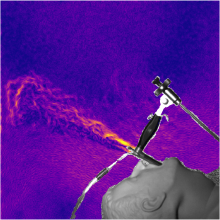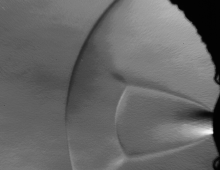Explore the Flow Physics and Imaging Lab's research facilities, publications to date, and ongoing research projects.
Facilities
TRIREME Water Tunnel
The Turbulence Research, Imaging, high-Resolution Experimental Methods, and Education (TRIREME) Water Tunnel is a water tunnel specifically designed to provide an ideal testbed for novel, flow visualization-based experimental techniques and for fundamental studies of turbulence. It features a 30 cm x 30 cm x 1 m test section and a maximum velocity of 1 m/s. The laboratory is outfitted with state-of-the-art equipment for high speed (up to 1 MHz) imaging and stereoscopic 1 kHz PIV. The side walls of the test section can be replaced with blocks which have inserts for high-quality optical glass with λ/10 flatness. These windows allow schlieren-based techniques such as BOS to be performed in the TRIREME tunnel without the optical distortions that would typically occur in water tunnels due to lower optical quality glass or acrylic windows.
HOPLITE 2-stage light gas gun
The hypervelocity projectile light gas gun (HOPLITE) is a two-stage light gas gun that is used to launch projectiles to hypersonic speeds for aerodynamics research. The bore diameter is 18 mm, and it is capable of launching models at speeds up to 4 km/s. The HOPLITE was funded by a Defense University Research Instrumentation Program (DURIP) grant from the Air Force Office of Scientific Research, and was constructed by Physics Applications, Inc.
Publications
For a full list of Professor Schmidt’s publications, including those prior to his position at Case Western Reserve University, please see his Google Scholar page.
Current projects
Risk Evaluation for Aerosol-Generating Procedures
In collaboration with Dr. Scott Howard at University Hospitals, we are applying background-oriented schlieren (BOS) imaging to evaluate the risk to healthcare providers associated with a variety of aerosol-generating procedures, including intubation/extubation and jet ventilation. An objective of this work is to make the BOS technique accessible to non-experts, such as medical doctors at other hospitals around the country. FPI Lab's wOFA-based BOS algorithm will be publicly available soon via an ImageJ plugin through this project funded by the NIH.
Stagnation Point Injection in Hypersonic Flow
Blowing a jet of gas from the nose of a hypersonic vehicle could have benefits including drag reduction and cooling at the stagnation point, both of which would have massive benefits for future hypersonic vehicles. The same fundamental flow is an enabling technology for human-scale missions to Mars, known as supersonic retropropulsion (SRP). In collaboration with Prof. Joe Jewell at Purdue University, we are studying the interactions between the jet at the stagnation point and the oncoming free stream in a project funded by the Air Force Office of Scientific Research. You can see videos here and here.
Tomographic Background Oriented Schlieren for Wildfires
In collaboration with Prof. Sam Grauer's group at Penn State University and Prof. Ya-Ting Liao at CWRU, we are developing a new 4D (3D in space, plus time) diagnostic tool for analyzing the complex flow structures in wildfires in a project funded by the NSF. The technique is based on background oriented schlieren imaging, but includes physics-informed models to improve accuracy and computational efficiency. The tool will have applications outside of wildfires as well, for instance in hypersonic flows.
Water Entry of Hypervelocity Projectiles
In a project funded by the Office of Naval Research Young Investigator Program (YIP), we are researching the effects of projectiles entering water at hypersonic speeds. We are particularly interested in the changes which occur when the projectile impacts the water at supersonic speeds relative to the speed of sound in water, which is about 1.4 km/s. We are performing experiments using the HOPLITE and high speed imaging, as well as partnering with the Naval Surface Warfare Center to simulate the flow phenomena using high-fidelity computational tools.
Hypervelocity Boundary-Layer Transition
We are studying boundary-layer transition at high Mach number, at realistic flight enthalpy using the HOPLITE in a project funded by the Air Force Office of Scientific Research Young Investigator Program (YIP). Specifically, we are interested in the effects of airborne particulates and nose bluntness on the transition behavior. We use high speed imaging to characterize the transition location and determine the properties of the instabilities that drive transition.







